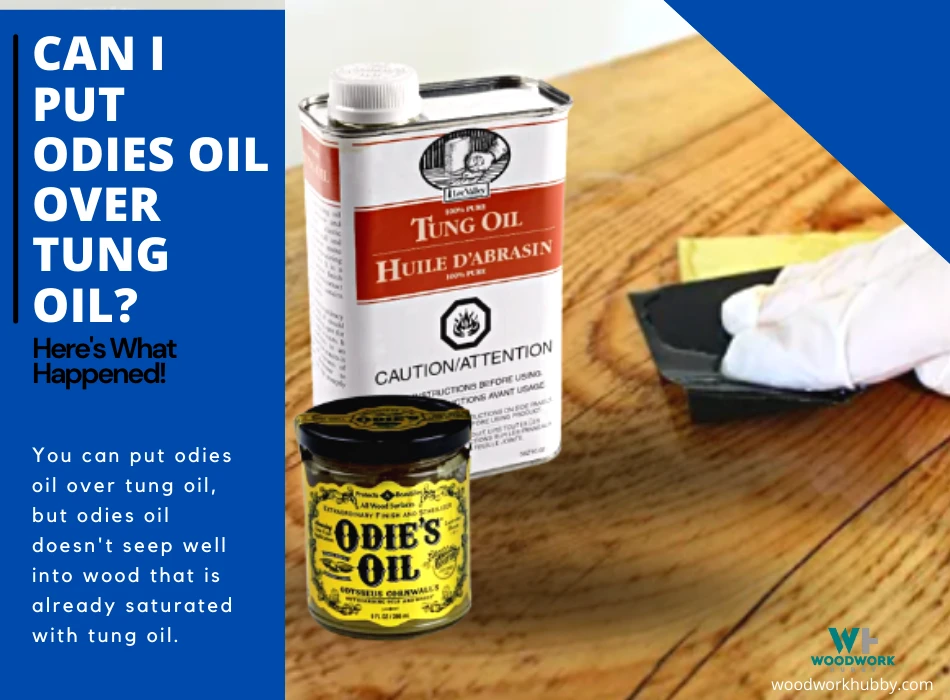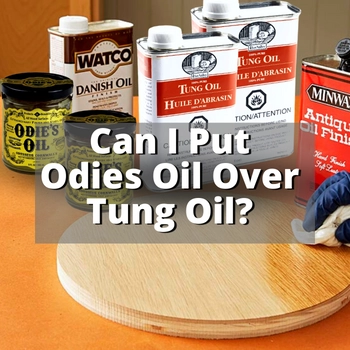If you love the appearance that Odie’s oil gives a wooden surface, you might wonder if you can give your previously tung-coated projects an Odie’s oil top-up. I have tried putting odies oil over freshly cured tung oil as well as on old fading tung-oil-coated projects, and I learned something.
You can put odies oil over tung oil, but odies oil doesn’t seep well into wood that is already saturated with tung oil. The ideal time to apply odies oil over wood that was previously finished with tung oil is 3 months.

In this article, we will go over the ins and outs of using tung oil and Odie’s oil in conjunction, as well as the benefits and drawbacks of each one if you use them individually (which is highly recommended). You will also learn about Odies oil and how it relates to tung oil and Danish oil. So, let’s get started.
Is Odie’s Oil Tung Oil?
Odie’s Oil is tung oil modified by a formula that is proprietary and protected as a trade secret. In other words, Odie’s oil is tung oil with additives that are unknown. But according to the manufacturer’s claims, the enhancement doesn’t make the oil unsafe for food-contact surfaces or toxic.
The video shows Odies oil, Tung oil, Danish, and, poly acrylic comparison on Walnut reclaimed beam
Tung Oil is limited to the advantages of a single-origin natural oil. Odie’s oil uses a wide range of natural oils and waxes, compounding their relative strengths and weaknesses. It offers benefits that are virtually the same as artificial finishes, yet they are sourced to be 100% natural.
The Tung Oil finish seeps deep into natural wood, while Odie’s Oil finish covers all the bases. Odie’s is more obvious on the upper layer and can seep as deep into the wood as Tung Oil.
This means Odie’s oil can be used in any application where tung oil is recommended. However, it isn’t the same as tung oil. It is better. It is 100% waterproof, lasts longer, and can be used in a more protective capacity than tung oil.
Both Tung oil and Odie’s oil take the same time to be dry to the touch, yet Odie’s cures much quicker. After 48 hours, Odie’s oil finish is ready for project use, while tung oil can take up to 3 days to fully dry.
Tung oil can be boiled or mixed with chemicals to hasten the curing process. However, the resulting mix becomes toxic and unsuitable for food-safe surfaces.
Odie’s oil, therefore, can be a better option than chemically-enhanced tung oil. In fact, any situation where you need tung oil to dry faster or last longer is a context where you’ll be satisfied with Odie’s oil.
Tung oil can be used in similar applications but with its limitations in mind. Tung oil needs to be reapplied every month for a year. Once it fully saturates the wood, it has to be applied once a year. In contrast, Odie’s oil can last 2 to 3 years with a single application. Of course, you can reapply it once a month to keep its polish fresh-looking.
It is also possible to use both Tung and Odie’s Oil on a single wood surface. Please note that this is a suboptimal choice. Tung oil is often used in conjunction with other natural oils, but since Odie’s oil also contains tung oil, using both is redundant.
Odie’s oil doesn’t fully saturate wood if a portion of the wood is drenched with tung oil. Even after drying, a surface is not ready to soak up as much of Odie’s oil if any other oil or wax has previously adorned it.
If you choose to use tung and Odie’s oil together, make sure that you use tung oil first. Odie’s, as mentioned earlier, seeps to the wood’s core but also seals the top to the extent that tung oil cannot penetrate wood as much. If you use tung oil first, the wood surface is still receptive to other finishes, including Odie’s oil.
Odie’s oil seals wood but doesn’t create as strong of a sealing layer over the wood as some of the more chemically-enhanced finishes. Odie’s oil seeps deep into wood pores and seals them internally.
But if your idea of sealing entails creating a complete coat over the surface, neither tung oil nor Odie’s oil can fulfill your requirements.
To seal the wood in a layer-protective way, you need an oil or resin that can harden on top of the wood, creating a protective layer that doesn’t slide off the wood. The product must anchor into wood pores while creating a layer over the wood surface.
Regular wood sealers don’t do this to the extent that Odie’s oil does. But compared to tung oil, Odie’s has a higher sealing effect.
Check out my article Is Tung Oil Food Safe? 10 Things You Need To Consider!
Odie’s Oil vs. Wood Sealers
Chemical finishes and wood sealers last 2 to 3 times longer than Odie’s Oil, but Odie’s Oil is food-safe and enhances the natural beauty of wood without interfering too much with the grain or surface texture.
Odie’s oil, therefore, ranks in the middle of the sealing effectiveness order. It is effective enough that it can be used on surfaces that come in contact with water, yet it isn’t so effective that you can use it for underwater projects. Both tung oil and Odie’s oil can be used to seal the wood to an extent.
The video shows odies oil application and impressions.
But if your end goal is to seal the wood, and the food-safeness or chemical content of the sealer doesn’t matter, you should go with Minwax Polycrylic Wood Finish as it is 3 times cheaper than 100% pure tung oil and 4 times cheaper than Odie’s Oil Universal Finish.
The reason for choosing Odie’s is not that it is cheaper or lasts longer. Rust-Oleum Polyurethane lasts longer, but Odie’s looks better. Odie’s oil brings out the natural beauty of wood.
Odie’s oil objectively looks better than a wood sealer. Sealers generally have a varnish-like appearance. The satin finish ends up darkening the wood, while the glossy finish looks wet all the time. This can cheapen natural hardwood furniture and products.
Are you having second thoughts on which you should choose between Tru Oil vs Danish Oil? Check out my detailed article!
Can You Put Odies Oil Over Danish Oil?
You can put odies oil over Danish oil as Danish oil doesn’t create a topcoat that repels odies oil. Oldies is positioned as a universal finish because of its excellent adhesion to surfaces with varying degrees of smoothness.
Therefore, odies can be applied to any surface regardless of which finish has been applied to it prior to Odie’s oil. That said, you must remember that Odie’s oil is best applied as the only finish.
For maximum effectiveness, Odie’s oil needs to saturate the wood, which is not possible if a finish creates a top layer that prevents Odies oil from seeping in.
It is also not possible if the finish saturates the core of a piece of wood. Danish oil is a culprit of both to an extent. It excessively drenches the top creating a shiny top layer. And if you take its cross-section, you can see that it goes deeper, albeit not drenches as much wood. Both of these leave very little room for oldies oil to make its mark.
This means you should either pick Danish oil for your wood project or go with Odie’s oil. Danish oil and Oldie’s oil have similar drying periods. Odie’s oil, however, lasts longer. Where Odie’s needs to be freshened up every year to two years, Danish oil needs to be topped up every 3 to 4 months. Danish oil is also food safe when it is fully dry.
But when a surface is in frequent use, it is better to use Odie’s oil. Let’s suppose you have wooden bowls you take out once in a blue moon. Those can be coated with Danish oil. But if you have a cutting board you use every day, Odie’s oil will be better.
Danish oil can be used in every context where Odie’s oil can be used. They are interchangeable except for maintenance and appearance. Danish oil darkens wood to an extent, while Odie’s oil changes the visual temperature of wood.
If you choose to use both Danish Oil and Odies, make sure the one that goes on earlier is applied thinner.
Can I Use Danish Oil On Oak Veneer Doors? I explain this in my article. Be sure to take a look.
Uses of Odie’s Oil
So far, you know that you can replace 100% tung oil as well as danish oil with oldies oil. But let’s look at what oldies oil is used for outside of a comparative context. This can help you decide whether the rather expensive finish is good for you.
Finishing Wood
Odies oil is, first and foremost, a wood finish. It looks beautiful and avoids darkening wood, which is why it is often chosen for more expensive varieties of wood. It brings up the temperature of the wood it is used to finish.
Waterproofing Wood
Wood surfaces like cutting boards often get wet because of food items with moisture. Waterproofing wood using chemical sealers is dangerous for this type of wood. However, odies oil is all-natural, which makes it an excellent choice for waterproofing food-contact surfaces.
Protecting Wood
Odies oil contains tung oil and other natural oils and waxes that individually protect the wood. When combined, their protective effects compound, resulting in a durable and aesthetic finish.
Final Thoughts – Can I Put Odies Oil Over Tung Oil?
You can put odies oil over tung oil, but if you can delay the odies topcoat by a month, you will get better results. Tung oil saturates the wood, which doesn’t leave too much room for Oldie’s oil to seep into wood fibers.
That is why I recommend letting tung oil fade a little before you put in the odies oil. But if you want to do it right away, just make sure the tung oil finish is fully cured first.




